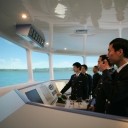消防基本英语 - 请对照学习
以下是我在做实习生的时候摘录的一些基本消防知识,大家可以结合中文教材学习
希望各位贤兄有所收获。
Fire stationsThe purpose of the fire-main system is to deliver water to the fire stations that are located throughout the ship. A fire station consists basically of a fire hydrant (water outlet) with valve and associated hose and nozzles. It is important that all required firefighting equipment be kept in its proper place.Fire stations and hoses must be highly visible and easily put into service. However, this visibility makes them vulnerable to misuse and damage. One type of misuse is washing down decks and bulkheads. The valve or piping can be damaged if it is used as a cleat for typing a line. Hydrant valve stems can also be damages during the handling of cargo or the moving of heavy materials through passageways. Hydrants located on weather decks may become corroded or encrusted with salt, causing their valves to freeze in position and become inoperable. When a section of hose or a nozzle is borrowed for use at another station, at least one fire station is made useless as a firefighting unit. Couplings and hoses that are abused (as by being dropped or dragged on the deck) may fail in use or, at least, become difficult to connect.Crew members should make every effort to protect all parts of fire-main system and avoid unauthorized use of the system. Weekly visual inspection of fire stations should be a standard procedure to ensure that all required equipment is in its proper place. Different hydrants should be opened during succeeding weekly fire drills to ensure that water is allowed to flow from each hydrant at least once every 2 months. This will reduce rust. (Whenever the opportunity arises, the fire main system should be flushed out with fresh water to destroy any marine growth in the lines.)Fire station locationsFire stations are located to ensure that the water streams from at least two hydrants will overlap. Hydrants should be located following the regulations as follows:1. Fire hydrants shall be sufficient in number and so located that any part of the vessel, other than main machinery spaces, is accessible to persons on board while the vessel is being navigated, and all cargo holds may be reached with at least two streams of water from separate outlets. At least one of these streams shall be from a single length of hose.2. In main machinery spaces, all portions of such spaces shall be capable of being reached by at least two streams of water, each of which shall be from a single length of hose and from separate outlets.3. Fire stations should be numbered sequentially as required by regulations.If deck cargo is carried, it must be stowed so that it does not block access to the fire station hydrant.HydrantsThe fire station hydrant has three major components: 1)a control valves; 2)the hose connection; and 3)a hose box.Regulations require that:1. Each fire hydrant outlet must have a valve that allows the hose to be removed while there is pressure to the fire-main system.2. The fire hydrant outlet may be in any position, from horizontal to pointing vertically downward. It should be positioned to minimize the kinking of the fire hose.3. The threads on the fire hydrant outlet must be national standard fire-hose coupling threads. The standard threads allow all approved hose to be attached to the hydrant.4. A box (or rack on some vessels)must be provided for the proper stowage of the fire hose. The hose must be stowed in the open or where it is readily visible any easy to take.All water enters the fire-main system through the sea chest, which is frequently covered with marine growth. It would thus be a good practice to fit all hydrant outlets with self-cleaning strainers. These strainers remove matter that might clog the nozzle, particularly the fire hoses in combination nozzles and low-velocity applicators.Fire hose and nozzlesThe efficiency of a fire station depends largely on the equipment stowed at the station and its condition. A single station should have the following equipment.HoseA single length of hose of the required size, type and length: 63.5 mm diameter hose is used at weather-deck locations; 38.1 mm diameter hose is used in enclosed areas. The hose must bear the Underwriters Laboratory label or comply with federal specification JJ-11-571 or ZZ-11-45 1a. Unlined hose may not be used in machinery spaces. The hose couplings must be of brass, bronze or a similar metal and be threaded with national standard fire-hose coupling threads.The hose must be 15m in length, except on the weather decks of tankers. There, the hose must be long enough to permit a single length to be goosenecked over the side of the tank ship. Goosenecking is directing a stream of water over the vessel's side, perpendicular to the water su***ce.The fire hose must be connected to the hydrant at all times, with the appropriate nozzle attached. However, when a hose is exposed to heavy weather on an open deck, it may be temporarily removed from the hydrant and stowed in a nearby accessible location. Fire hose may also be temporarily removed when it might be damaged by the handling of cargo. (When fire hose is removed, the exposed threads of the hydrant should be covered with a thin coating of grease and a protective screwcap. If a screwcap is not available, a heavy canvas, lashed over the threads, gives some protection.)Fire hose may not be used for any purpose other than firefighting, testing ad fire drills.NozzlesA nozzle preferably of the combination type, so that water flow may be controlled must be connected to the hose at all times. Tank vessels must be equipped with combination nozzles throughout. The combination nozzle must be fitted with a control that permit the stream to be shut off and to be adjusted for solid stream of high-velocity fog. Other useful tools (fog applicator)A spanner wrench whose size matches the hose coupling, or an adjustable spanner wrench depending on the location of the fire station is required. Fire hoseA fire hose is a flexible tube that is used to transport water from the hydrant to the fire. Most of the hose in use is lined to stand up user high water pressure and minimize friction loss. The lining is usually constructed of a rubber or synthetic material. Its inner su***ce is very smooth, so water will flow through it with a minimum of friction. The outer covering of the hose is a jacket of heavy cloth or synthetic material. The hose has a male coupling at one end and a female coupling at the other; these couplings are sometimes called butts. The female coupling is attached to the hydrant, and the male coupling to the nozzle.The fire hose is the most vulnerable part of the fire-main system. It is easily damaged through misuse. Failure to remove dirt, grease, abrasives and other foreign substances from the outer su***ce of a hose can cause it to fail under pressure. Fire hose may be cleaned by washing with fresh water and mild detergent, using a soft brush. Abrasive cleaners should not be used as they cut into the outer covering of the hose and weaken it.Hose that is dragged across metal decks can be permanently damaged. The jacket may be cut, or the coupling threads may be bent or broken. Failure to drain hose thoroughly, prior to racking, allows trapped moisture to cause mildew and rot; possibly resulting in failure under pressure. In addition, cold, heat and seawater tend to weaken the hose.Fire hose should be inspected visually each week. Every hose on board should be tested monthly, through actual use under the pressure required to produce a substantial water stream. This can be done by alternating weekly fire drills from station to station, or through a rotating testing schedule.Fire hose should be taken from the box periodically and visually inspected for dry rot and other damage. For the stowage of the hose at the fire station, we should:1. Check the hose to make sure it is completely drained. Wet hose should not be coiled and stowed.2. Check the female coupling for its gasket. 3. Coil it well and put it in the fire hose box.NozzlesNozzles are quite rugged nut are still subject to damage. For example, the control handle can become stuck in the closed position, owing to the corrosive action of seawater. Combination nozzles are often clogged by pieces of dirt that enter and collect around openings. Periodic testing and maintenance will help detect and correct deficiencies.Spanner wrenchesA spanner wrench is a special tool designed specifically for tightening or breaking apart fire-hose connections. The spanner should match the hose size and butt configuration.-----------------------------------------------------
2nd Officer
Ever-student from Dalian Maritime University
Be proud of DMU
请登录后发帖

 联系我们人工客服
联系我们人工客服



















 :1391995811
:1391995811

